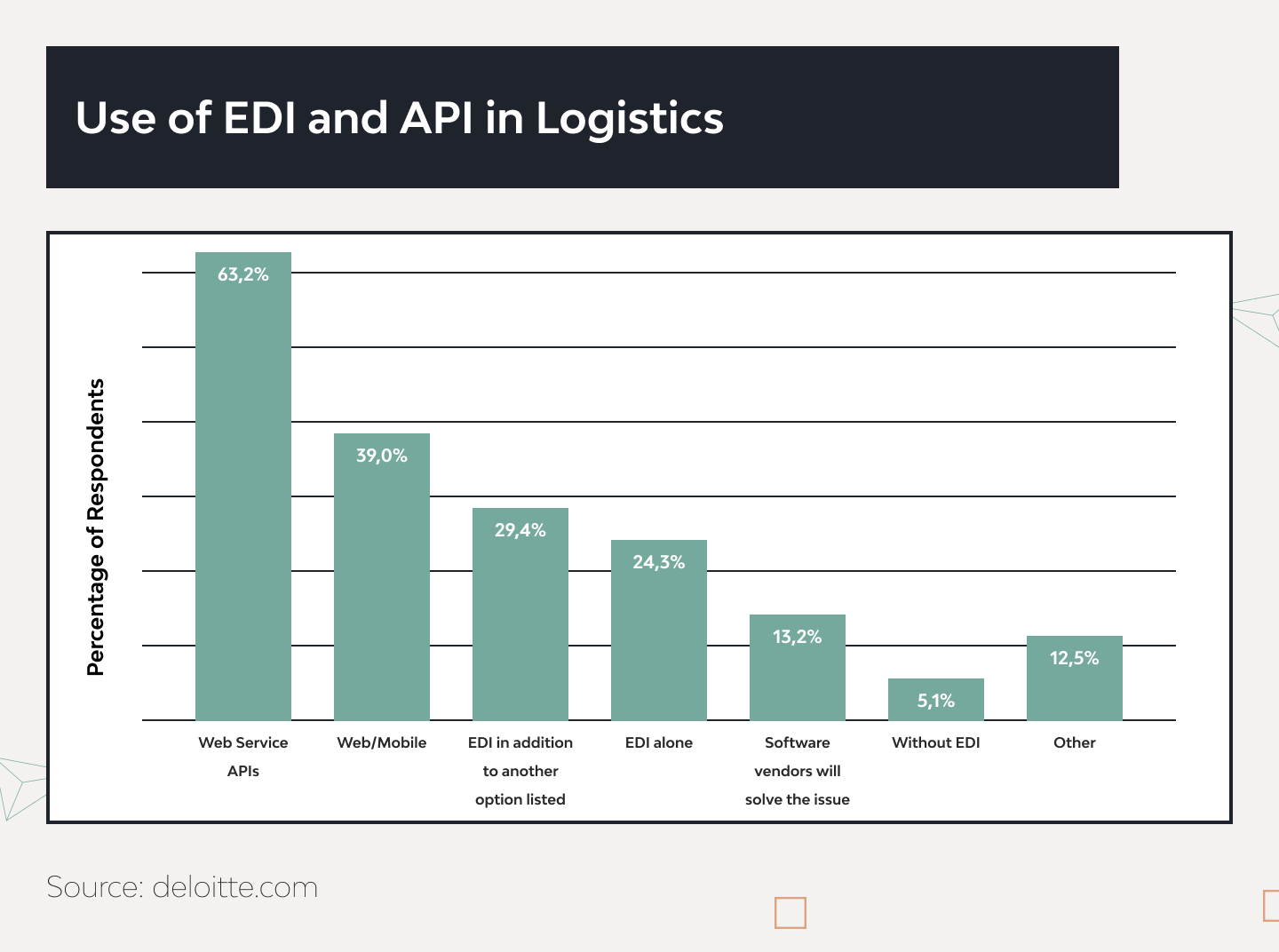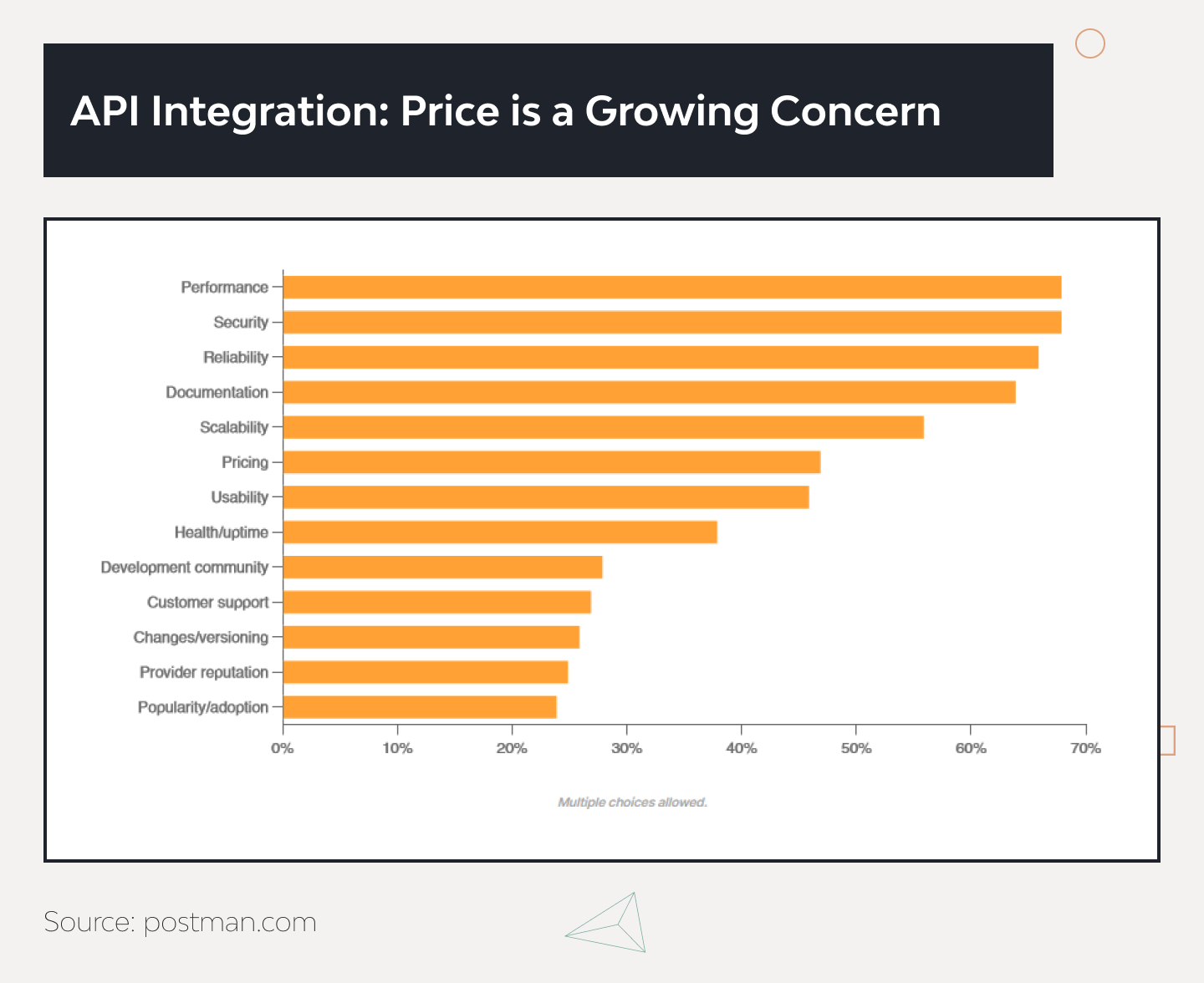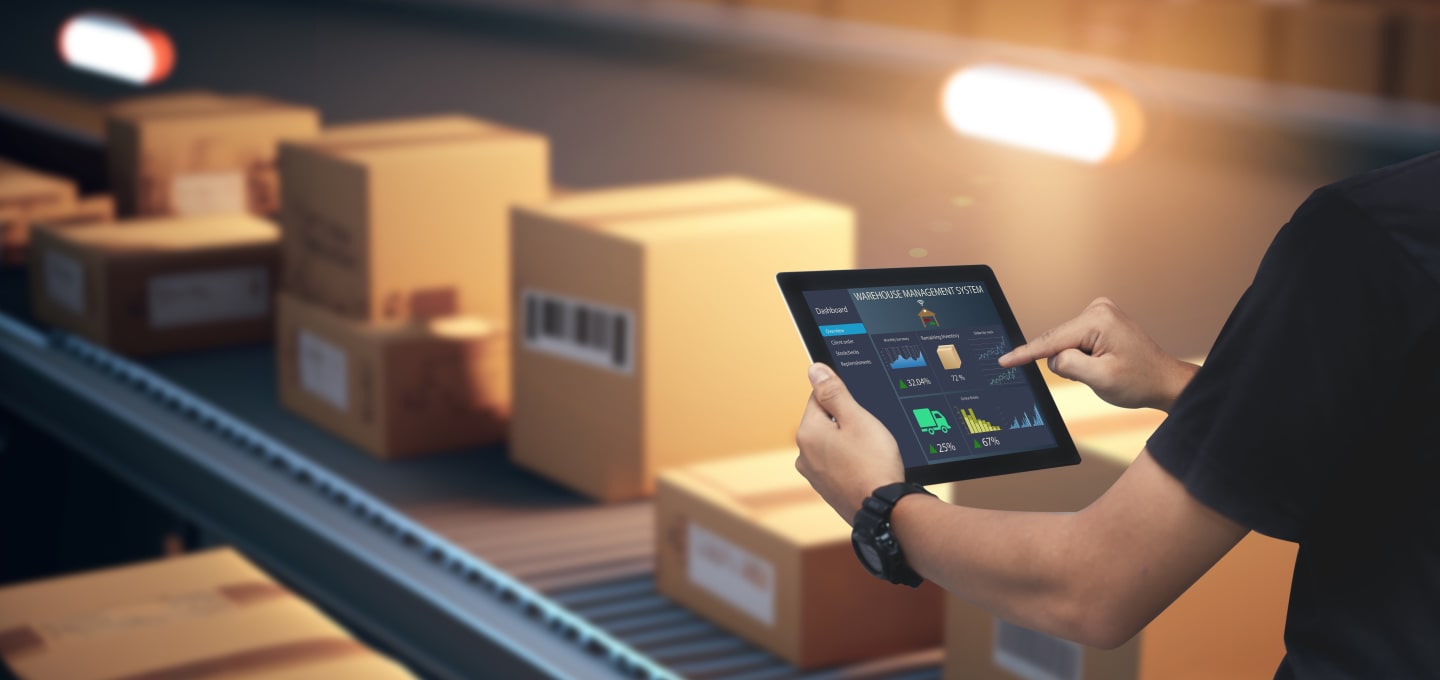EDI vs API Integration in Logistics: Which One is the Best?

In logistics, where timely and accurate delivery requires seamless communication, the role of reliable data exchange systems cannot be overstated. They directly affect key operational aspects such as inventory management, order processing, real-time tracking, and overall supply chain coordination. And when it comes to customer satisfaction and cost efficiency, every minute counts.
Two of the most common technologies facilitating data exchange in modern logistics are electronic data interchange (EDI) and application programming interface (API). They enable the swift and reliable transfer of critical data across various stakeholders, ensuring that every link of the supply chain is informed and synchronized.
This article examines API and EDI integration — from improving efficiency to influencing the strategic capabilities of logistics operations. We explore the distinct characteristics, strengths, and limitations of EDI and APIs, providing insights into their significance in today’s transportation and distribution networks. With this knowledge, supply chain professionals can make more informed decisions, choosing the right technology to meet their specific needs and stay ahead in a rapidly evolving industry.
What are EDI and API in logistics?
EDI and API are widely used in business communication for data exchange between companies and organizations.
There are lots of discussions about what tool is better in logistics. It’s a complicated issue because business demands are changing, and new challenges are emerging. A logistics company must choose the proper tool wisely, considering its capabilities and features.
Electronic Data Interchange or EDI is a data exchanging technology using automatic b2b communications. It was designed in the 1970s but is still widely used because it provides solid stakeholder communication. Of course, with the development of modern technologies, EDI principles and procedures have changed, but it remains a global standard for exchanging information in logistics.
Application Programming Interface or API has similar capabilities but uses different techniques to transfer data. It uses a connection between applications, not direct transferring. API is more intuitive because it usually has a more straightforward interface.
Read Also: Connecting Shippers and 3PL Providers
There are dozens of APIs for different data transfer types suitable for e-commerce, social network interactions, financial activities, logistics, and many other business branches. However, API is sensitive to digital ecosystem integration but is flexible and allows companies to connect with partners and SaaS applications quickly and efficiently.
In 2021, IBM estimated that over 85% of large companies worldwide had used EDI in their supply chains. But in this report, IBM referred to Gartner, which predicted that API would be used in at least 50% of world supply chains.
In 2022, almost 70% of e-commerce sales in the USA were performed with EDI systems. On the other hand, in Deloitte’s “The Future of Electronic Data Interchange (EDI)” research, we can see that only 24.3% of respondents used EDI and nothing more. And 63.2% of managers said their companies used web service APIs for data transmission.

The global market size of EDI is estimated to be $1.98 billion in 2023. At a GAGR of 12.5%, it would more than double and surpass $4.52 billion by 2030. Still, the API market shows phenomenal growth. Some experts claim its GAGR is 31.05%; others are more humble in their calculations and estimate it at 23.83%, but it’s still a lot — an average growth rate for an IT global market is 8.2%.
In 2022, the API market size was equal to EDI’s, but it’s considered one of the fastest-growing IT technologies. Experts forecast it would hit $32.7 billion in 2030 — over ten times growth during eight years.
There is a severe spread of API use between different business branches. Technology and IT services sectors are leading in adopting API solutions, but the other niches could be represented better.
Still, almost all entrepreneurs realize the importance of API solutions in the future. Over 92% of respondents said they would keep the level of investments in API systems or even increase them.
Sure, the data is controversial and may be interpreted differently. There are some changes and dynamics, but it’s early to determine what data exchange solution is better or has more perspectives on a global scale. API systems are rapidly developing, but EDI is still a solid and reliable solution in any business area.
EDI vs. API: Key Differences, Pros and Cons
Let’s deal with the pluses and minuses of both ways of data exchange. Although EDI and API are used for similar purposes, the ways data is transmitted are different. Adopting one of them has its pros and cons. You can determine which way best fits your big data needs by analyzing each.
Even though the API technology appeared later, there is no definite answer to which one is better for logistics businesses. Many influential market players still use EDI and are going to keep everything the same.
EDI and API technologies are different even though they are used for similar purposes. So, let’s compare them by several vital criteria for logistics companies.
| EDI | API | |
|---|---|---|
| Protocols in use | Standard data transmitting protocols like FTP or AS2 | Standard cloud-based data protocols like SOAP, REST, RPC, or others. |
| Implementation process | EDI may be integrated with legacy systems but requires converting all the data into a specific format. | API is not compatible with legacy systems. It requires serious developing skills to implement and demands extra caution at the testing phase. |
| Functionality | Many market leaders have already implemented electronic data interchange solutions. They provide fast data transfer but are limited by EDI standards. | There’s no need to match data format when exchanging or connecting with established systems like TMS, WMS, and ERP. API systems can proceed with vast data amounts and quick data transfer. |
| Security | EDI systems provide a high-security level because the connection is established only between two predefined authorized users. | API depends on web applications, making it more vulnerable to data leaks. |
| Accessibility | EDI technology is a proven standard in logistics and many other business areas. | API solutions are becoming increasingly popular nowadays, but companies that have used EDI for a long time find it extremely difficult to switch to API. |
EDI Pros
- Security. EDI-based systems are well secured. Connection is established only between two parties, and data are transferred directly through a secured channel. Moreover, only authorized users may access the data, with no exceptions.
- Usability. EDI makes working with data much easier for both parties and reduces time for document processing. Also, it’s pretty simple — any employee can learn to operate it entirely within a month.
- Accessibility. EDI is an industry standard, so many big players in the market use it already.
EDI Cons
- Sensitivity to versions. For establishing communication, EDI versions must match between partners. If they’re not, proper data transmission would be impossible.
- Limited partners number. EDI is designed to share data between two parties. It’s a bit complicated to add another one into a single system.
- Outdated technology. In 30 years of existence, the technology remained almost unchanged. That’s why data transmission time strongly depends on the data amount and is much lower than modern tools may offer.
- High price. EDI is a costly tool to implement. It requires fully manual customization, and its adoption may last 3 to 6 months.
EDI is a common choice in the supply chain industry — 59% to 84% of logistics companies use EDI solutions. But setting up high-load processes is difficult — only 10% of logistics operations can be fully automated.
Despite the EDI technology’s standards being designed decades ago, they are developing now. For example, large companies try to improve their EDI-based supply chains by adopting AI and ML predicting analysis, creating blockchain EDI transactions, and even cloud-based EDI solutions. It improves much slower than API, but there are positive changes that provide market growth.
API Pros
- Faster data transmission. API systems allow the exchange of data within seconds. The speed of data transmission is from 5 to 40 times faster than EDI systems can operate. Also, an API system allows pickup data requests in auto mode, so data is available even during non-working hours.
- Simplicity. API systems don’t require an exact match of software versions or data types.
- Technology compatibility. API is designed to enhance the benefits of modern technologies. It’s highly compatible with software logistics tools. For example, API uses blockchain to provide outstanding data visibility and control. It has an extensive space for improvements.
API Cons
- Developing technology. That’s a disadvantage because many prominent players in an international market still use EDI and refuse to switch to API.
- Lack of Security. API is web-based technology, so it’s more affected by data breaches than EDI systems.
- Depends on a stable internet connection. Fast and stable internet is a crucial point for any API system.
In Postman’s 2023 State of the API Report, the companies that provided an API-first working environment were asked about the benefits of this strategy. Over 88% of respondents were sure that API-first companies onboard and integrate with partners better and are generally more productive. Also, 78% of managers reckon that businesses using API launch new products faster and create better software, and their staff are happier.
Performance, security, and reliability are the top three factors companies evaluate before integrating with an API. Also, executives pay serious attention to scalability, documentation, pricing, and usability.

Factors to consider when choosing between EDI and API integration
The choice is quite difficult. That’s why we designed a step-by-step checklist to help you understand what kind of system would be better for your logistics company.
- Determine the data types you need to share with contractors. EDI is a perfect choice if you need to share standardized data like invoices, payment data, shipment information, etc. API is way better when you primarily exchange unstructured data — for example, images or text descriptions.
Imagine a world-known shipper with a large vehicle and ship fleet that delivers goods worldwide. It works in a strictly regulated industry, so security is its #1 priority. In this case, EDI is the best choice cause this data exchange type has way better data safety than most API solutions. Moreover, if the data types are standardized, it would be easier to set up the system.
- Evaluate the existing infrastructure. Both EDI and API logistics tools require specific software. Switching between EDI and API when all processes are established is pricey and inconvenient for all parties. But still, you may combine separate elements into a solid and variable ecosystem.
Businesses don’t have to pick one or another solution. Despite the differences, EDI and API may be united into a single ecosystem. But it’s quite an unpopular solution because of a sky-high price and implementing complexity — it’s affordable only for national or international market leaders. Also, it requires a vast in-house or outsourced team of developers to set up and support.
Here is the image of one of the options for how EDI and API may work inside an ecosystem.
- Consider the difficulties of tool adoption. EDI requires highly specialized expertise to implement. If you have limited technical resources, it’s better to pick API tools.
- Calculate the price. EDI solutions are usually expensive, especially for extensive facilities. Still, API adoption may also be pricey — it all depends on the difficulty of tasks and the level of integration into a supply chain. Nevertheless, point API solutions may be affordable even for small businesses.
The price difference between EDI and API solutions is significant. For example, here is Amazon’s example of how the price is calculated for using AWS Data Exchange solutions.
Suppose you have a data set containing 100 GB of structured data. Staff members and partners must have access to it 24/7. You would pay only $33.30 monthly: $1 for each day of round-the-clock access and $2.30 for monthly data storage. The price of API implementation is also pretty affordable because a small team or even a few experienced developers can solve the task.
On the other hand, an EDI monthly license would cost $3000, the lowest price on the market. An average option for a mid-sized logistics company is about $6000. The installation and configuration are not included. Sure, there are options based on the number of transactions, but they are also expensive. One thousand transactions would cost $150 to $250.
- Consider the system’s flexibility. EDI is strictly standardized, so its customization for unusual tasks may be limited. If you want more operational freedom, choosing API solutions is better.
- Determine the required security level. Experts don’t recommend using API to exchange the most sensitive data because system leaks may compromise the entire ecosystem. EDI tools are considered safer to use, but they still depend on system features and support.
- Find out the scalability options needed. API systems are easily scalable, so even if a company is growing fast, it wouldn’t be a problem. EDI tools are much less flexible and may require significant resources to enhance.
- Check the required technical expertise. EDI and API integration require a completely different technology stack and experience. Moreover, API tools are still updating and changing, so adopting them may require additional resources to improve the system.
EDI and API solutions may be designed with different programming languages and frameworks. For example, EDIFACT and ANSI X12 are two commonly used languages in EDI systems. They are outdated, but almost all EDI solutions are based on them.
The number of options for API is way more considerable — Python, R, MATLAB, and up to a dozen other programming languages. But Django Stars reckon that Python is the best choice. We work closely with Python-based APIs written in the Django framework.
For example, we’ve designed a data exchange infrastructure for a leading US food service included in the Fortune 500 list. After restructuring logic process flows and redesigning user experience, we’ve developed a secure and convenient data exchange ecosystem for better data processing and decision-making.
Read more about our experience in creating software in logistics.
Conclusion
Before choosing EDI or API tools, entrepreneurs should consider many things. There is no single way to determine whether it is better for your company — it all depends on the nuances of everyday tasks, partner software, plans and strategies, available budgets, and other vital features.
Many large logistics companies continue to operate EDI solutions, and many small businesses and startups prefer using API.
Remember that the point is not about what ecosystem is better. Instead, question yourself about what solutions will bring more benefits. Moreover, it’s unnecessary to pick one — combining different elements of EDI and API into a solid system that meets all business requirements is possible.
- Can EDI and API integration be used together?
- Yes. they can. A combination of EDI and API may provide a profitable solution for logistics companies. For example, EDI may be used for transferring payment information, invoices, and sensitive data, and API — for exchanging other types of files or designing real-time data transmitting processes.
- How long does it take to implement EDI or API integration?
- It greatly depends on the complexity of the chosen solution. Implementing full-fledged EDI tools may take from 3 to 6 months. Still, complicated API solutions may require lots of time to deploy, but point ones may be integrated in days.
- What is better: EDI or API?
- It depends on the tasks you want to solve with data exchange system integration. EDI may be a better option if you need to share structured documents with your clients and contractors. On the other hand, API is required if you want to set up real-time data transfer. It’s wrong to ask what is better. Instead, find out what exactly you need.









